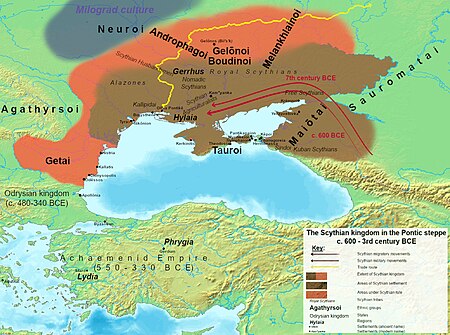Gelonians
The Gelonians or Geloni (
Location

The Gelonians lived alongside the Budini in the valley of the Vorskla river.[1]
History
Origins
The Geloni likely originated as a group as the Scythians proper who lived in the Pontic steppe, due to which their name appears in the Scythian genealogical myth along with the Agathyrsi.[2]
Like the Agathyrsi, the Gelonians lived outside of Scythia and were independent of the Scythian kingdom.[3]
According to Herodotus, Geloni (Γελωνοὶ) were originally Greeks who settle among the Budini and their language evolved into half Greek and half Scythian. Their temples were of Greek style and they worshipped Greek gods among others. On the other hand, Budini didn't speak the same language and their manner of life was different.[4][5] Adding that the Greeks were calling the Budini too Geloni but this was wrong.[6]
Pavel Jozef Šafárik wrote that they "might be Greeks among the Slavs and Fins. Such Μιξέλληνες (half Greeks half barbarians) were common enough in the towns upon the Euxine." Schafarik believed that the Budini belonged to the Slavic family.[7]
Gelonus
During the 6th century BC, the city of Gelonus was built in the country of the Budini, where the Gelonians set up an important industrial, commercial, and political centre.[8] The Gelonians and Budini both lived in Gelonus, although each population lived in separate sections of the city: the Gelonians lived in the eastern earthwork, where was located the city's industrial, commercial, and political centre; the poorer native Budini lived in the western earthwork.[9][10]
The Persian invasion
When the Persian Achaemenid king Darius I attacked the Scythians in 513 BC, the Scythian king Idanthyrsus summoned the kings of the peoples surrounding his kingdom to a meeting to decide how to deal with the Persian invasion. The kings of the Budini, Gelonians and Sarmatians accepted to help the Scythians against the Persian attack, while the kings of the Agathyrsi, Androphagi, Melanchlaeni, Neuri, and Tauri refused to support the Scythians.[11]
During the campaign, Darius captured the city of Gelonus and set it on fire.[8]
Society and culture
Appearance
According to Herodotus of Halicarnassus, the Geloni were different in appearance from the Budini who lived alongside them.[1]
Lifestyle
The sedentary Gelonians were wealthier than the nomadic Budini, and they were engaged in agriculture.[12]
The Gelonians lived in the city of Gelonus, which was built entirely of wood,[13] This city was protected by a defensive system of three earthworks surrounded by ramparts.[8] The present-day site of Bilsk hillfort has been identified with Gelonus.[8][10]
Language
The Gelonians were described by Herodotus of Halicarnassus as speaking a different language from the Budini.[12] According to him, their language was half Greek and half Scythian.[4]
Religion
Herodotus of Halicarnassus mentioned that, every three years, the Gelonians performed a Bacchic-type festival which he interpreted as a festival to the Greek god Dionysos.[14][15]
Herodotus also claimed that the Gelonians built sanctuaries to their gods (whom he claimed were Greek gods), although this has not been archaeologically verified yet.[15] This was in contrast to the Scythians proper, who did not built shrines to their gods.[16]
Crafts
The Gelonians and Budini brought ores from outside to the industrial section of the city of Gelonus, where iron and copper were smelted from them.[10]
Trade
The Gelonians and the Budini participated in the ancient trade route which started from the ancient Greek colony of Pontic Olbia on the northern shore of the Black Sea and continued to the north-east into the steppe and forest-steppe regions.[10]
Archaeology
The Gelonians corresponded to a group of the archaeological Scythian culture which was located outside of Scythia.[3]
References
- ^ a b Sulimirski 1985, p. 185.
- ^ Sulimirski 1985, p. 189.
- ^ a b Sulimirski 1985, p. 168.
- ^ a b Herodotus, The Histories, 4.108
- ^ Perseus Encyclopedia, Geloni
- ^ Herodotus, The Histories, 4.109
- ^ Dictionary of Greek and Roman Geography (1854), Geloni
- ^ a b c d Sulimirski 1985, p. 187.
- ^ Sulimirski 1985, p. 187-188.
- ^ a b c d Sulimirski & Taylor 1991, p. 588.
- ^ Herodotus & Godolphin 1973.
- ^ a b Sulimirski 1985, p. 188.
- ^ Parzinger 2004, p. 79.
- ^ Braund 2021, p. 189.
- ^ a b Parzinger 2004, p. 72.
- ^ Cunliffe 2019, p. 269.
Sources
- Braund, David (2021). "Heracles' Footprint by the River Tyras: Immortality and Acculturation on the Geto-Scythian Frontier". In Braund, David; Stolba, Vladimir F.; Peter, Ulrike (eds.). Environment and Habitation around the Ancient Black Sea. ISBN 978-3-110-71570-5.
- ISBN 978-0-198-82012-3.
- JSTOR 3269235. Retrieved 26 November 2021.
- ISBN 978-3-406-50842-4.
- ISBN 978-1-139-05493-5.
- ISBN 978-1-139-05429-4.
- Dictionary of Greek and Roman Geography (1854), Geloni

